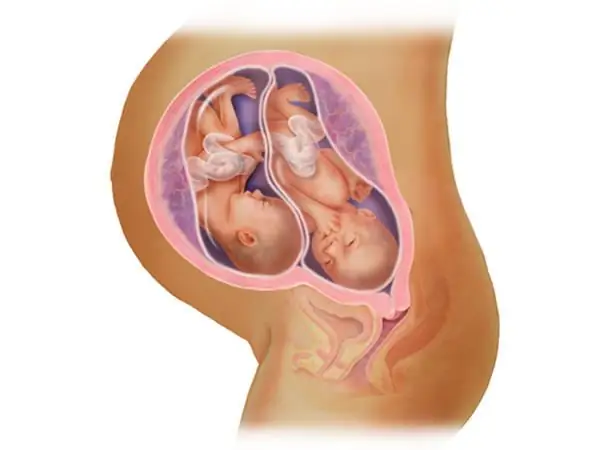2026 Author: Priscilla Miln | [email protected]. Last modified: 2025-01-22 17:55:29
During the ultrasound procedure, the doctor conducts a special protocol. In it, he enters all the information about the growth and development of the baby. One of the most important parameters of the protocol is the biparietal head size. In this article, we will talk about what is fetal BPD by week and why you need to know about it during pregnancy.

Indicator value
The brain is the most important human organ. Proper development of the fetus directly depends on the state of the brain of the baby. During the ultrasound, the doctor pays special attention to the study of the child's head, calculates the BDP of the fetus by weeks. This determines how well the fetus develops. The biparietal size is the distance from the temple to the temple of the child, measured along the minor axis. That is, a kind of "width" of the head. Another important indicator of ultrasound is the distance from the forehead to the back of the head along the major axis (LZR). But the biparietal size is of decisive importance during pregnancy. Quite accurately it is set for a period of 12 to 28 weeks. In addition to the fact that BPD of the fetal head speaks of the correct intrauterine development of the baby, heindicates the possibility of physiological childbirth. In case of serious deviations, the question of childbirth by caesarean section may arise.
Biparietal size - norms of indications
To make it easier for a doctor to navigate in terms of norm and pathology, special tables have been developed. They show the average biparietal size norms using percentiles. This is medical statistics, in which the upper (95 pr.) and lower limits (5 pr.), as well as average indicators (50 pr.) are indicated. How is the rate of fetal BDP determined by week? The table represents percentile scores. The doctor finds the 50th value and looks at the boundaries of extreme indications. For example, at 12 weeks, the BDP norm is 21 mm. In this case, the permissible deviations are 18-24 mm. Therefore, mom should not worry if she sees in the protocol, for example, the value of BDP 21 or 22. The main thing is that they be less than the upper limit.

Danger of deviations
Sometimes the doctor sees that the fetal BDP by week is not within acceptable limits. What can it say? To begin with, the specialist evaluates other indicators of the fetus (abdominal circumference, thigh length, etc.). If all indicators go beyond the normal range, this may indicate a large fetus or an abrupt growth. In the second case, with a second ultrasound in a couple of weeks, the numbers are likely to even out. If the indicators of BDP of the fetal head greatly exceed the norm, this may indicate serious problems with the he alth of the baby. Increased size occurs with brain tumors or othermalignant tumors, cerebral hernia, hydrocephalus. In the latter case, the woman's pregnancy is taken under special control. As a rule, prescribe treatment. In especially difficult situations, the question of termination of pregnancy is raised.

Such a solution can be offered for cerebral hernia and brain tumors, since these pathologies are incompatible with life. No less severe consequences threaten the reduced size of the fetal head. This indicates the pathology of the brain, for example, the absence of its vital structures: the hemispheres or the cerebellum. According to such indications, pregnancy is terminated at any time. If a reduced BDP is found in the third trimester, this may indicate intrauterine growth retardation syndrome. In this case, drugs are urgently prescribed to improve uteroplacental blood flow (for example, the drug "Actovegin", etc.).
Recommended:
Can an ultrasound not show pregnancy? Fetal size by week of pregnancy

There are times when women find out they're pregnant when they're well into their term. There are quite a few ways to confirm a special situation using the analysis of hCG, various tests. But sometimes, the listed methods do not always carry reliable information. Can an ultrasound not show pregnancy? We'll talk about it in this article
Location of the uterus by week of pregnancy. How the size of the uterus and fetus changes every week

Already from the first week after conception, changes imperceptible to the eye begin to occur in the female body. During the examination, the gynecologist can determine the onset of pregnancy by the increased size and location of the uterus. By weeks of pregnancy, an accurate description is provided only according to the results of an ultrasound examination
The formation of the fetus by week of pregnancy. Fetal development by week

Pregnancy is a quivering period for a woman. How the baby develops in the womb by weeks and in what order the baby's organs are formed
Fetal CTG is the norm. Fetal CTG is normal at 36 weeks. How to decipher fetal CTG

Every expectant mother dreams of having a he althy baby, so during pregnancy she worries about how her child develops, is everything okay with him. Today, there are methods that allow a fairly reliable assessment of the condition of the fetus. One of them, namely cardiotocography (CTG), will be discussed in this article
Fetometry of the fetus by week. Fetal size by week

For any future mother, it is necessary to be sure that her baby is developing correctly, without various deviations and disorders. Therefore, after the first ultrasound examination, a pregnant woman learns about such a concept as fetometry of the fetus by weeks. Thanks to this type of ultrasound examination, you can find out the dimensions of the body parts of the fetus, make sure that the gestational age set by the doctors is correct and see possible deviations in the dynamics of the child's development

